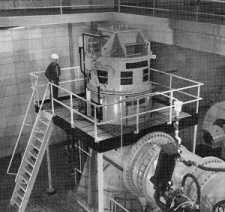A civil engineering company in Chicago was hired to determine the start-up torque for a column pump at a water treatment plant for the City. The City desired to upgrade the pump drive system by employing reduced voltage starters to minimize in-rush current.
Some of the oldest pumps in the system required extra power during start-up, nearly twice the operating horsepower, depending on the open or closed state of the discharge valve. This problem could be resolved by over-sizing the motor (a costly option) or by optimizing the timing of the discharge valve opening, relative to the torque load. Both options pointed to one question: How much torque is required for starting the pump?
Engineers used Binsfeld telemetry to transmit live torque signals from Micro-Measurements strain gages on the impeller drive shaft while simultaneously monitoring RPM with a tachometer during trial start-ups. The torque and RPM data provided the information engineers needed to make informed decisions on how to best optimize the pump performance. In a matter of hours, real impeller torque measurements pointed to a conclusive solution that would otherwise be only guessed at based on time consuming and complicated modeling.

